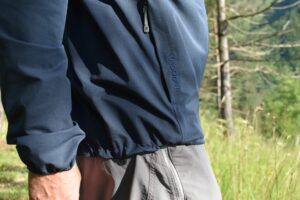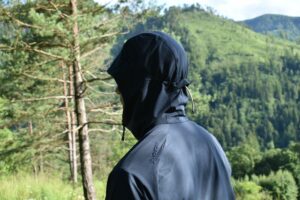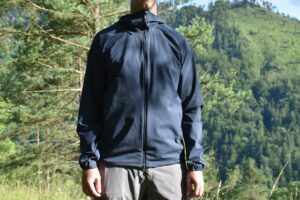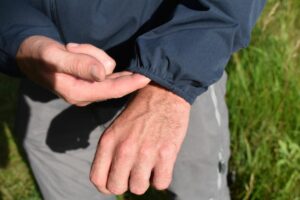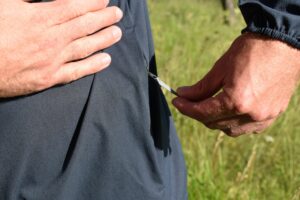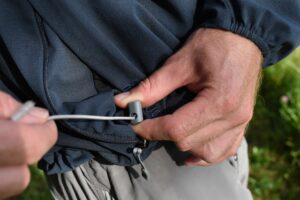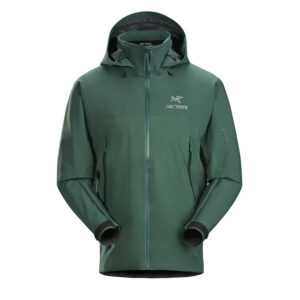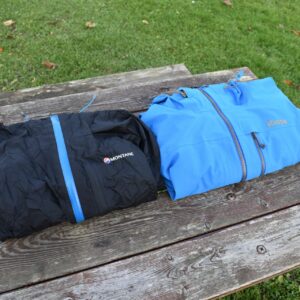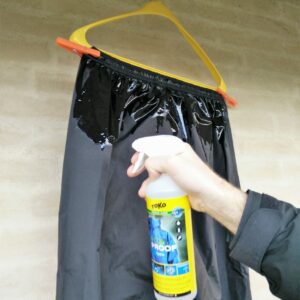In late May I received the Houdini Daybreak jacket for testing in exchange for an unbiased review. Since then, I’ve been wearing it regularly for hiking, mountaineering, everyday use and even cycling. The Houdini Daybreak is a lightweight softshell jacket which is designed for outdoor activities in windy conditions and/or light rain. When I unpacked the jacket, I was happy to see that the fabric is very thin, soft and flexible. I have wanted such a softshell jacket for a long time. The thin and stretchy fabric does not only make the jacket more comfortable to wear but also more versatile. It can be worn year-round as it provides very little insulation. For the last three months I’ve been wearing the Houdini Daybreak jacket regularly, investigating its functionality, protection against the weather, fit and performance. Below is what I learned about it.
The Houdini Daybreak Jacket is suitable for:
- Hiking
- Mountaineering
- Trekking
- Backpacking
- Climbing
- Everyday Use
Materials
The Houdini Daybreak jacket is made of tightly woven polyester (38% of which is recycled) and treated with a fluorocarbon-free (PFC-free) durable water repellent (DWR). The fabric is made with a ripstop reinforcing technique which increases the durability of the jacket. When I unwrapped the jacket, I was positively surprised by the materials. The fabric is softer, stretchier and thinner than any other softshell jacket I’ve had. When I wore the jacket for the first time, I quickly figured out that it’s very comfortable and provides great freedom of movement. Due to the thin fabric, it’s also quite lightweight. It weighs only 14 oz. (400 grams) which is indeed not a lot for a softshell jacket. I also found the other components of the jacket such as the zippers, drawcords, elastic cuffs etc. to be of high quality. So, all in all I was very satisfied with the materials. Every component of the jacket is sturdy, yet lightweight. The jacket is made in Portugal, which means that the workers have been paid and treated fairly.
Weather Protection and Breathability
When I started wearing the Houdini softshell jacket for hiking and alpine ascents, I quickly noticed that it provides superb breathability. The thin polyester fabric is extremely good at letting the moisture and warm air escape to the outside, which made me a bit worried if it would consequently provide inferior rain protection. Nevertheless, it has blocked the rain efficiently so far. Maybe not as good as some of my previous softshell jackets but I can’t really count this as a downside due to the extra breathability the Houdini Daybreak offers. A softshell jacket is anyway not something you wear for heavy rain (unless unexpected), and in light rain the Houdini jacket has always kept me dry. I’m also very satisfied with wind resistance. The jacket efficiently blocks wind and keeps you warm. As the fabric is very breathable, you might feel the strongest wind gusts coming through but that’s barely noticeable. These characteristics make the Houdini Daybreak jacket perfect for highly aerobic activities such as mountaineering and speed hiking.
Functionality and Features
The Houdini Daybreak jacket more or less follows the current trends for softshell jackets with regards to features, albeit with a few neat additions. The jacket has two large zippered hand pockets and two even larger stash pockets on the inside. One of the hand pockets doubles as a stow pocket. This is indeed a very neat feature at it allows you to pack the jacket for transport. The pocket zippers are durable and have pull loops so you can easily use the pockets even when you are wearing gloves. I was, however, a bit annoyed that the two zippers often catch on the fabric on the sides and get stuck. To fix it, you have to pull the fabric away from the zipper firmly, but gently.
The hood has a brim for extra protection against the rain and can be adjusted with a drawcord. The adjustment point is at the back of the hood and enables you to shorten or lengthen the circumference of the hood. This very simple adjustment system works really well, and the hood nicely follows the curve of your head when it’s adjusted properly. The Daybreak jacket also has a high collar that comes all the way up to the nose when the jacket is fully zipped. I really like such a feature when it comes to shell layers. However, the collar of the Houdini jacket is too wide to fit snugly around the neck and thus doesn’t provide very good protection against the wind in this area, even if zipped all the way up. I found this to be the biggest downside of the jacket. The collar should simply be more tight-fitting.
The jacket also has an adjustable hem (via a drawcord in the right hand pocket) and elastic cuffs. At first, I was a bit skeptical about elastic cuffs because all my previous softshell jacket had Velcro cuffs. Nevertheless, I found elastic cuffs great and very convenient. As opposed to Velcro cuffs, you don’t have to loosen and tighten them when you put on gloves or check the time on your watch.
The Houdini softshell jacket is also equipped with a two-way zipper in the front. This is very useful when you are wearing a climbing harness because it enables you to unzip the jacket from the bottom. The zipper seems high-quality but sometimes it does require a bit of force to get the bottom two pieces together.
In terms of odor resistance, I was a bit disappointed with the jacket. It seems that it’s not treated with any antimicrobial agent as it becomes smelly quite fast. I didn’t have this problem with my previous softshell jackets.
Fit and Sizing
According to the size guide on Houdini’s website I was between size M and L. I decided to go for size L, so that the jacket wouldn’t be too small for layering. Nevertheless, size L was way too large for me and I had to return it. I replaced it for size M which fits me great. My chest diameter is 98 cm (38.5 in.) and I’m 180 cm tall (5 ft. 11 in.). The jacket has slightly longer sleeves and a drop-tail hem for additional coverage. I really like that the sleeves are a bit longer. Because of that they don’t ride up, even during more technical activities such as scrambling.
Washing and Drying
The jacket is machine washable at 30° C but you should steer clear of aggressive detergents. It also shouldn’t be tumble dried. After washing it, you should reapply DWR to restore water resistance. Alternatively, you can also wash it with a DWR detergent such as Nikwax SoftShell Proof

Houdini Daybreak Softshell Jacket: It is easy to adjust the hood
Verdict
The Houdini Daybreak is a great lightweight softshell jacket with a few minor flaws. I was impressed with the fabric which provides good weather resistance although it’s incredibly breathable. The jacket is also quite stretchy and thus provides great freedom of movement. The fabric is pleasant to the touch and therefore you can easily wear the jacket over a t-shirt in warm weather. I was also very happy with elastic cuffs which are much more convenient than the more commonly used Velcro cuffs. Nevertheless, the Houdini jacket disappointed me a bit in terms of odor resistance. It becomes smelly fast and thus you basically have to wash it after just a handful of high-intensity activities. I was also a bit annoyed with the pocket zippers which often catch on the fabric, and the (too) wide collar which doesn’t fit snugly around the neck.
If you have any questions about this product, drop me a line in the comments below.
Rating
| Design |  |
| Quality |  |
| Comfort |  |
| Functionality |  |
We field tested this product. The rating shows its overall performance.About Rating
Pros:
- Breathability
- Elastic cuffs
- Packs into its own pocket
- Stretchy and soft material made of partly recycled (38%) polyester
- Lightweight
Cons:
- Too wide collar
- Odor resistance
- Pocket zippers often catch onto the fabric


